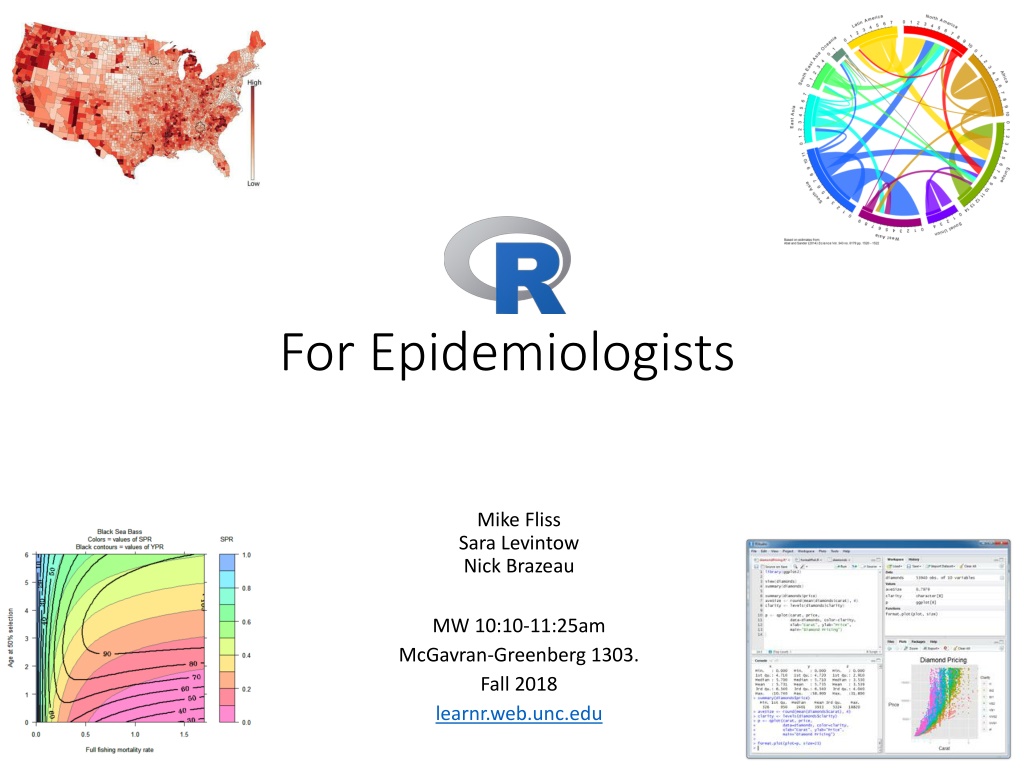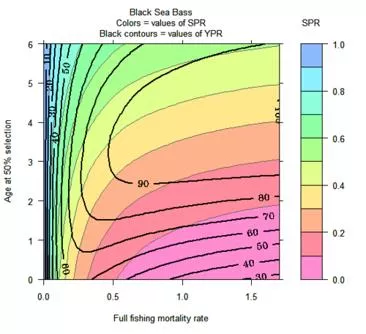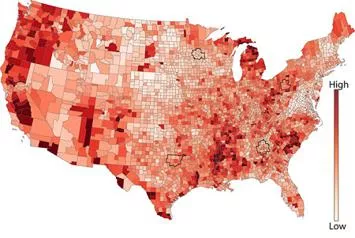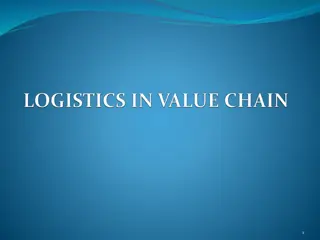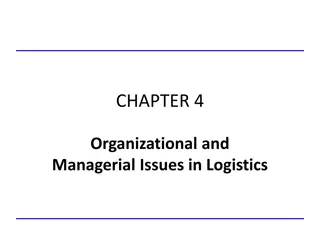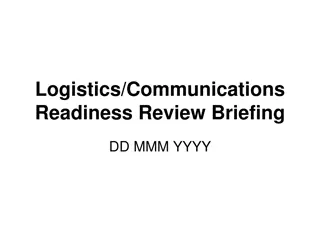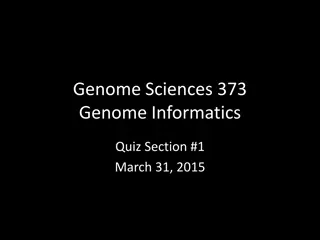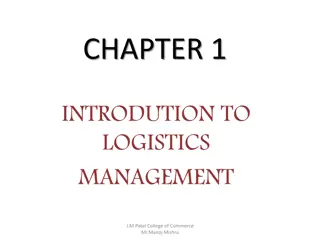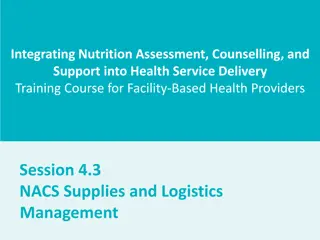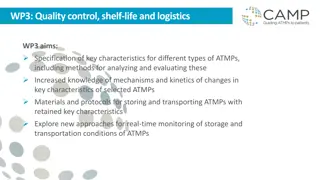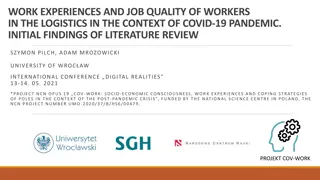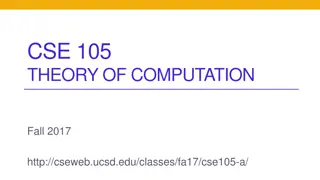Epidemiologists Course Overview and Logistics for Fall 2018
Explore the detailed course overview and logistics for epidemiologists in the fall 2018 semester. From introductions to course progression and practical assignments, this document provides essential information for those familiar with programming languages like SAS. Discover the approach, format, and goals of the course, emphasizing hands-on learning and practical applications in epidemiology.
Download Presentation

Please find below an Image/Link to download the presentation.
The content on the website is provided AS IS for your information and personal use only. It may not be sold, licensed, or shared on other websites without obtaining consent from the author.If you encounter any issues during the download, it is possible that the publisher has removed the file from their server.
You are allowed to download the files provided on this website for personal or commercial use, subject to the condition that they are used lawfully. All files are the property of their respective owners.
The content on the website is provided AS IS for your information and personal use only. It may not be sold, licensed, or shared on other websites without obtaining consent from the author.
E N D
Presentation Transcript
For Epidemiologists Mike Fliss Sara Levintow Nick Brazeau MW 10:10-11:25am McGavran-Greenberg 1303. Fall 2018 learnr.web.unc.edu
Welcome to Campus / Welcome to Campus / Acknowledging a Acknowledging a Victory! Victory! Useful Resources Library Guide to History of Silent Sam Teaching after Silent Sam UNC Dept of History statement The Center for the Study of the American South
Welcome & Overview Welcome & Overview Website, syllabus, course format, homework
Welcome & Overview Welcome & Overview Course logistics Introductions Website: learnr.web.unc.edu Sign up sheet (see website) Google group (see website) Datacamp (optional) Syllabus review All about R How is R different from SAS? How do I install R/Rstudio? Homework Hopefully ready today, but if not: Install R and RStudio for next class! Handle logistics! Registration, get data, sign up sheet, google group, etc.
Introductions Introductions Who you are What program / year you re in Why you re in the class What experiences (other language experience, content areas, etc.) you re hoping to contribute Please (all, including auditors!) fill out the sign-in sheet while listening!
Back to the Course: Approach and Format Back to the Course: Approach and Format Course theory: Designed for those familiar with SAS or another programming language. Using dataset and questions from EPID core curricula (births, disparities) Practical. See, try, modify, why, apply. Logistic goals: Minimal out-of-class responsibilities. Project: Direct relevance to your existing work. Wind down assignments before the end-of-semester rush.
Back to the Course: Approach and Format Back to the Course: Approach and Format Course progression: Part one: Language basics / Core R Part two: R packages & homework. Part three: special topics lectures Use any resources you want! Internet searches, forums, books, other open courses Group work on exercises is encouraged but not required (don t just copy ) Better to turn in broken/incomplete code you kind of understand (so we can help) instead of working code you don t understand. R is open and collaborative! Practice that here!
Student Responsibilities and Expectations Student Responsibilities and Expectations Class exercises Follow along with example code, activities, interactive exercises in R. Work in small groups always allowed. Find folks with similar schedules! Homework Five assignments during middle half of class, due on Mondays Generally lags the class material Follows a single dataset (NC Births) through steps of a public health analysis We ll work on in class, & handhold through hardest parts (e.g. HW2 apply) Project Last 1/3 of the class (but start thinking about now, or midway through) Dataset / question of your choice, ideally something useful for you Share a few slides with the class to show off your work at the end
Student Responsibilities and Expectations Student Responsibilities and Expectations Outside Learning if you have time for immersion! Datacamp: Got the class an upgraded education account to all the tutorials on DataCamp invites to come through the class roster. Outside Reading: Lots of good, free books (or pay to get paper copies). R for Data Science is a great introduction, and Advanced R is excellent for serious under-the-hood and why does that work stuff. Subscribe to key blogs, the Rstudio blog or the GitHub repositories of your favorite packages. Like learning a new language try to speak it = code something most days to keep the learning going. R is a different modality than you might be used to (functional programming, etc.).
Lets Talk R! Let s Talk R! Open source programming language and software environment for statistical computing and graphics Created by Ross Ihaka and Robert Gentleman (University of Auckland, New Zealand) Currently supported by the R Foundation for Statistical Computing (Vienna, Austria) More info on the history of R at https://www.R-project.org/
From The Popularity of Data Science Software By Robert A. Muenchen http://r4stats.com/articles/popularity/ Popularity of Popularity of
From The Popularity of Data Science Software By Robert A. Muenchen http://r4stats.com/articles/popularity/ Growth of esources Growth of esources R jobs surpassed SAS jobs in 2016
Growth of esources Growth of esources R surpassed SAS in scholarly article citations in 2015, continuing the trend. From The Popularity of Data Science Software By Robert A. Muenchen http://r4stats.com/articles/popularity/
Growth of esources Growth of esources
Why ? Important features: Why ? Important features: Free: costs nothing, runs anywhere, modify anything you want Popular: across disciplines, increasing prominence in epidemiology Powerful: do more with less (time, code, heartache) Efficient: good for big datasets, simulations, demanding calculations Flexible: do many things, in many different ways (error-checking) Transparent: you can look at how anything works, code sharing, etc. Community: package development, helpful people, fast bug iteration Higher level thinking: Avoid SAS card thinking. Abstraction and grammars And why RStudio? Short answer: super helpful It also looks similar to the SAS interface you re probably used to
Challenges of Challenges of Free: no one to sue! no centralized or official tech support. Popular: not entrenched! Resistance to change. Powerful: can require some different thinking. Obfuscated code. Efficient: thinking and coding efficiently takes work (disk v RAM?) Flexible: you can write rickety / Rube Goldberg code. Try not to. Transparent: sometimes you have to get into the guts. Can be gross. Community: Conflicts between people, packages, syntax. Higher level, abstracted thinking: is hard! All that and still VERY much worth it!
vs. No division of your code into PROC/DATA parts No separate macro language; variables, functions do this better Modern computer science language: functions, objects, abstraction SAS output is just output. R output is an object, so can be input, too. Graphical data exploration is easier in R, but takes learning
DATA births; RUN; SET epid.births; IF weeks >= 37 THEN preterm = 0; ELSE IF 20<=weeks<=36 THEN preterm = 1; births$preterm <- ifelse(births$weeks<37, 1, 0)
Todays Activity: RStudio Tour Today s Activity: RStudio Tour Install/Update R and Rstudio: Hopefully you ve done this, but if not: a help guide is available on the course website. We will be available during office hours (still figuring them, but likely right after class) if you are having trouble with this. Make sure R&RStudio work before you come to next class! We code every class. If you re not there yet, get a buddy to watch them do this next Rstudio tour!
RStudio IDE : A Guided Tour! RStudio IDE : A Guided Tour! Scripts, execution, comments, navigation, style (if we get to it today)
Rstudio 22
RStudio is an IDE! (an Integrated Development Environment ) A good IDE allows you to work at full speed. Is separate from R watch (or subscribe) for upgrades & read release notes References to check out later (also on website): https://www.rstudio.com/resources/webinars/rstudio-essentials-webinar-series- part-1/ https://www.rstudio.com/online-learning/#R http://programmers.stackexchange.com/questions/102018/what-features-of-an-ide-would-make-it-more-useful-than-a-general-purpose-editor https://channel9.msdn.com/Forums/Coffeehouse/106446-What-makes-a-good-IDE 23
RStudio Panes RStudio Panes Environment / History Script Editor Files, Plots, Packages, Help Console
Our first script: the absolute minimum Open and save R scripts with icons at top left of Editor No command terminator (farewell, semicolon! Can use if you want.) Use # for comments Use <- or = as assignment operator (reads as gets ) Example: x <- rnorm(100, mean=1.2, sd=3) # 100 from normal dist summary(x) # get summary stats plot(x) # plot these 100 values
We Try: RStudio IDE Layout Panes: use, navigation Help cheatsheets RStudio Running code Console, script, blocks, comments, inline (e.g. load()). Comments #, post-#, code blocks, comment blocks, links, code outline Key keyboard shortcuts https://support.rstudio.com/hc/en-us/articles/200711853-Keyboard-Shortcuts Alt-Shift-K Favs: control, panes, autocomplete, running code, F1 so many. Style R: http://adv-r.had.co.nz/Style.html Google: https://google.github.io/styleguide/Rguide.xml 26
You try 1) Create a new script window 2) Save your script as Births Analysis.R or something similar 3) Set up a comment header with info like your name 4) Set up a comment block or two: something like Reading Files & Loading Libraries 5) (For now) load the data using the Rdata file, and run a test expression or two on it. 6) You ve just got your first points on Homework 1!
Answers #............................ # Births 2012 Analysis for EPID 799C # Mike Dolan Fliss, August 2018 #............................ # Notes go here. #............................ # Libraries and working directories #### #............................ birth_file = "D:/User/Dropbox (Personal)/Education/Classes/18Fall_EPID799C_RforEpi/data/R for epi 2018 data pack/births_sm.rdata # Could use setwd() too. #............................ # ............................ # Read 2012 birth data #### # ............................ load(birth_file) # <- our first function #..................................................
